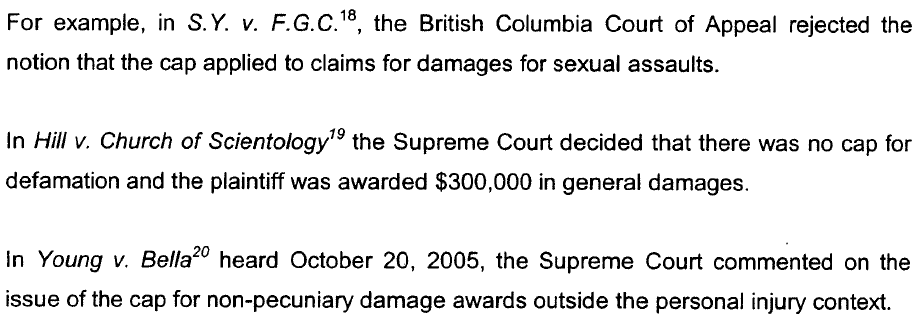Exception to Trilogy cap - negligence causing financial loss
Hi Graham,
Why is negligence causing financial loss non-pecuniary? Doesn't financial imply it is pecuniary?
In the case of Young v Bella (which I assume is the case for this exception), the poor student suffered tort injury due to negligence on the part of Prof who wrongly accused her of being a child abuser. The plaintiff was suing for:
1. damaged reputation
2. reduced future income-earning capacity due to her inability to complete education as a result of the event
1 is defamation, whilst I think 2 should be quantifiable in money and therefore pecuniary. I would guess that you can take the difference between an average salary of a social worker and that of a high school leaver, multiplied by the number of years the plaintiff can be expected to work, in order calculate the loss of future income.
I cannot find an example in the source paper to which this 3rd exception applies. =S
Comments
Everything you said makes sense. I only added this 3rd exception (negligence causing financial loss) because according to the examiner's report for 2018.Spring Question 6b, that was one of the required answers.
Note that this exact question has been asked 4 times prior to 2018.Spring and in each case they only asked for 2 exceptions. If you get this same question on a future exam and they only ask for 2 exceptions, I would list only "sexual abuse" and "defamation". If they ask again for 3 then put the "negligence" reason third, even if you think it's wrong.
The source text does state this as an exception, but there is confusion surrounding this in past examiner's reports.
Young v Bella
exceptions as per text

The three exceptions are discussed in Davidson. They are referring to non-pecuniary damages that are also part of a "negligence causing financial loss" case such as Young v. Bella where,
As you can see the non-pecuniary damages exceeded the cap (in a negligence case that was not related to a personal injury case).
You'll also note that in the case:
Hence - this is not defamation (although it seems the defense lawyers would've preferred a defamation case give this argument).
And finally, why we are reading it
A negligence case has larger potential for damage and fewer defense options. Negligence requires plaintiff to prove:
1. duty of care
2. breach of duty
3. damages
Defamation:
A better example might be if a credit agency (like AM Best) we to publish that insurer B had a "weak" BCAR score, because they incorrectly calculated their earthquake risk. As a result the Insurer had problems getting funds and selling insurance for 12 months. Insurer B could subsequently sue AM Best for negligence. In said case, Insurer B would not have a cap on non-pecuniary damages in said case (for example if insurer B could show they were unreasonable or lazy, or deliberate etc.). In reality any contract with a rating agency will remove the ability to sue for said damages.
Thank you for pointing out that Young v Bella was tried as a negligence case not defamation (I had the two mixed up in my head somehow). It certainly makes the argument for non-pecuniary damages more plausible.
Speaking of credit rating agencies, I think their contribution to subprime mortgage crisis in 08 would definitely fit the criteria of 'negligence causing financial loss'. It also imposed severe amount of pain and suffering for people whose savings were wiped out, because their pension funds invested in the "very safe", AAA-rated mortgage bonds and CDOs.
Maybe if this thing doesn't work out, we can all switch careers and become lawyers.
Just to point out: negilgence was NOT accepted as an exception in:
The examiner's report listed this answer as a "common mistake". But then in 2018.Spring Q6b, they did accept negligence as a valid exception. In fact, you had to list negligence as one of your answers because they asked for 3 items, not just 2.
I don't know what changed in 2018 because that reading has been on the syllabus for a long time.
That is correct, but unless someone filed a appeal we don't know how they would've scores a "perfectly worded" financial negligence clause. The reference to negligence was an "eg", which suggests it may have been clear, but I suspect the answers here were not specific enough to make it clear it referred to negligence cases not involving bodily injury.
Fall 2017 Q5B Common mistakes included:
Fall 2016 Q6B Common mistakes included:
This is why anyone taking CAS exams should be demanding the "official rubric" be released (vs. sample answers), otherwise the entire appeal process is not truly a open process.